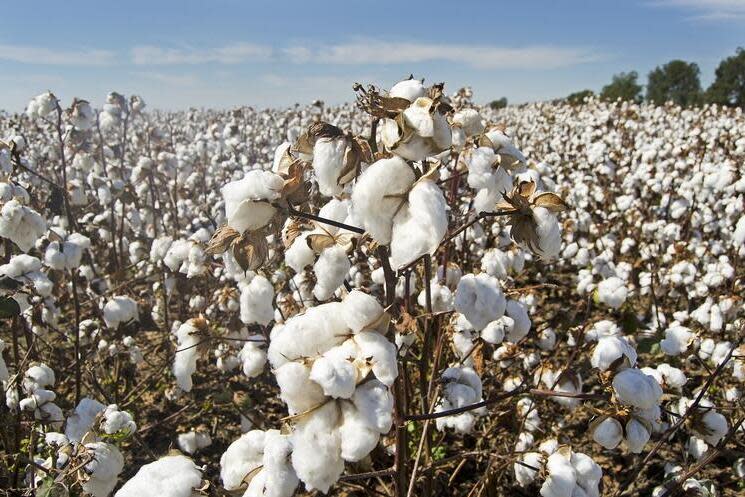Loran Smith: Boll weevils were the bane of a Georgia cotton farmer's existence for years

In the last fortnight, I rode by a farm in south Georgia where cotton was making its way toward harvest. It takes 200 days for cotton to mature into the fluffy white stuff which is most valuable to growers.
This brought about down-on-the-farm nostalgia, good and bad, but was also a reminder of how important this cash crop has been to farmers and agri-business historically in the South.
Georgia ranks third nationally among the cotton producing states in acres planted and also production. Cotton has always held sway in economic impact in our state.

Two things make cotton farming today different than in yesteryear: most significantly, the eradication of the boll weevil and the prevalence of mechanical cotton-picking machines.
Picking cotton was back-breaking work in the past, but the profit from cotton was so significant that doctors and lawyers, for example, plied their respective trade in town but owned cotton-producing land out in the county.
In 1785, many Georgians imported Sea Island cotton from the West Indies. Sea Island cotton had a long, strong fiber and was much in demand, but when Eli Whitney invented the cotton gin in Savannah in 1793, that brought about an opportunity for the shorter staple varieties of cotton to flourish. Unfortunately, that brought about the demand for cheap labor, hence slavery. Originally Georgia was not a slave state, but Whitney’s invention changed that.
Cotton’s annual value to our state’s economy is $1.5 billion. It remains a boon to big time farming. My daddy rented his farm of 300 acres and depended on a good cotton crop to pay bill and buy a little something special for the family. There was nothing he admired more than to survey his field of robust cotton blooming and maturing for harvest. He would walk out into the gleaming rows of cotton, smile and whisper a prayer of thanks as he bowed his head in reverence.
Loran Smith: Remembering John Underwood, a friend and great author on sports figures
Loran Smith: A visit to Arizona includes baseball and UGA accolades
He worked long hours to make ends meet, maintaining faith that there would always be a productive harvest. He prayed for rain when it was dry. He prayed for enough good days in late summer and early fall that would enable him to get the cotton picked before a hurricane came up from Florida and rained on the harvest.
He prayed that his crop dusting would kill the boll weevil, the bane of cotton farmers since the pest came up from Mexico in the early 1900s. He never worried about having a problem with toxic insecticides. He didn’t smoke and he was an advocate of clean living. Most of all, he had to provide for his family, and he felt the risk was worth it. His instincts were correct in that he lived to the ripe old age of 92.
A philosophical advocate of the Golden Rule, he did hold unrelenting contempt for the dastardly boll weevil, which he castigated for its cowardly ways, ruining a cotton crop like a thief in the night. When Tex Ritter sang the “Boll Weevil” song, depicting the boll weevil looking for a home, my father was not amused. The lyrics were clever, but prophetic. When the boll weevil found a home, it meant that there was nothing left to get out of debt in November.
There have been several songs written about cotton, in addition to the “Boll Weevil” song. It was Huddie William Ledbetter, better known as Lead Belly, who wrote the lyrics to “The Cotton Song” in 1940.
It was later recorded by Harry Belafonte, who died recently, and Johnny Cash among others.
It was a mournful tune that again testified to the wrath of the boll weevil. “When them cotton balls get rotten, you couldn’t pick very much cotton,” Lead Belly wrote. It was the boll weevil which made the cotton rotten.
The community of Enterprise, Alabama, used the boll weevil to turn a lemon into lemonade. An enterprising farmer talked his neighbors into planting peanuts instead of cotton. It worked. He made peanuts his main cash crop.
Cotton is a survivor, however. It has been around for more than 8,000 years. Its multiple uses are all about us every day, from clothing, bed sheets and towels. Also woven fabrics such as canvas and denim. Then there is cottonseed oil which you find in salad dressing and margarine; soap, candles and cosmetic products.
We have whipped the unprintable boll weevil and nobody has a backache from stooping over in the hot sun. Hallelujah!
This article originally appeared on Athens Banner-Herald: Cotton farming and boll weevils defined Georgia agriculture

